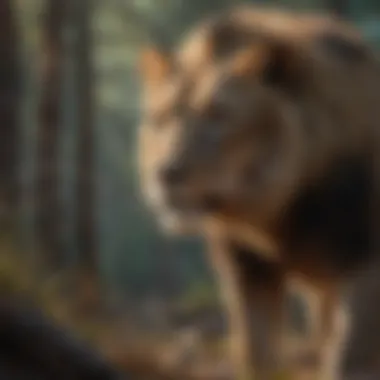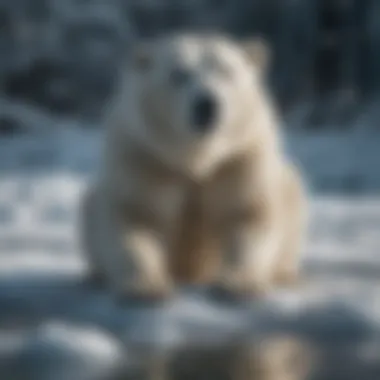Unveiling the Crisis of Animal Endangerment: Impact on Wildlife Exploration


Nature Topic Overview
In the realm of animal endangerment, a critical crisis unravels, casting shadows over the delicate balance of wildlife ecosystems. Habitat loss, poaching, climate shifts, and human-wildlife conflicts loom large, threatening the very fabric of biodiversity. The need for urgent conservation efforts to shield endangered species and safeguard nature's harmony has never been more pressing.
Wildlife Explorations
As we delve deeper into the intricacies of animal endangerment, the plight of various species come to light. Lions struggle for survival amidst shrinking habitats, while lush greenery faces devastation by human interference. These tales depict a somber reality where the impact of human actions reverberates throughout the animal kingdom. Through interactive quizzes and puzzles, young minds can grasp the challenges faced by these creatures, fostering empathy and understanding.
Environmental Awareness
Conservation and sustainable practices emerge as beacons of hope in the face of escalating endangerment. Educating children on the significance of preserving nature's wonders ignites a sense of responsibility towards our planet. Simple yet effective tips empower the younger generation to partake in the noble cause of protecting our environment. By instilling these values, we pave the way for a future where harmony between humans and wildlife thrives.
DIY Nature Activities
Engaging in hands-on activities allows children to bridge the gap between theory and practice. Crafting nature-inspired works of art or embarking on outdoor explorations infuses learning with creativity and excitement. Step-by-step guides unlock a treasure trove of possibilities, empowering young nature enthusiasts to explore and protect the world around them.
Introduction to Animal Endangerment
Animal endangerment is a critical issue that demands our attention. In this article, we will delve into the intricate complexities surrounding the decline of wildlife populations. By examining habitat loss, poaching, climate change, and human-wildlife conflicts, we aim to shed light on the urgent need for conservation efforts to protect endangered species and preserve biodiversity. These are vital steps towards ensuring a sustainable coexistence between humans and wildlife.
Understanding the Concept of Animal Endangerment
The Definition of Animal Endangerment
Animal endangerment refers to the precarious situation faced by certain species at risk of extinction due to various factors. This includes habitat destruction, illegal trade, and climate change. The definition underscores the urgency of addressing these issues to prevent irreversible harm to our ecosystem. Understanding the gravity of animal endangerment is crucial in implementing effective conservation measures.
Factors Contributing to Animal Endangerment
Several factors contribute to the endangerment of animals worldwide. Habitat loss, pollution, and human activities encroach on natural habitats, pushing species towards extinction. By identifying and addressing these factors, we can work towards sustainable solutions for preserving biodiversity and protecting vulnerable wildlife populations.
Significance of Wildlife Conservation
Preserving Biodiversity
Preserving biodiversity is paramount in maintaining a healthy ecosystem. It encompasses the variety of life forms and habitats on Earth, playing a crucial role in ecological balance. By safeguarding biodiversity, we ensure the long-term survival of species and ecosystems, promoting resilience against environmental disturbances.
Role of Endangered Species in Ecosystems
Endangered species play a vital role in ecosystems, contributing to their functionality and stability. From keystone species that exert disproportionate influence to indicator species reflecting environmental health, each plays a unique part. Understanding and conserving endangered species is fundamental to the health and balance of our natural world.


Causes of Animal Endangerment
In this article, the focus is on explaining the significance of the topic 'Causes of Animal Endangerment,' shedding light on specific elements, benefits, and considerations. This section addresses the crucial factors contributing to the decline of wildlife populations through habitat loss, illegal wildlife trade, poaching, climate change, and human-wildlife conflicts. By delving into these causes, the article aims to underscore the urgent need for conservation efforts to protect endangered species and preserve biodiversity.
Habitat Loss and Fragmentation
Impact of Deforestation
Exploring the specific realm of Deforestation's impact, this analysis delves into how the clearing of forests adversely affects wildlife habitats. Deforestation is a key contributor to habitat loss, disrupting ecosystems and leading to the endangerment of various species. By emphasizing the rampant deforestation practices worldwide, this article aims to raise awareness about its detrimental effects and the critical need for sustainable forestry practices.
Urbanization and Its Effects on Wildlife Habitats
Addressing the consequences of Urbanization on wildlife habitats, this section highlights the encroachment of human settlements into natural areas. Urban expansion results in habitat fragmentation, forcing wildlife to adapt to increasingly confined spaces or face extinction. The discussion will underscore the challenges posed by urbanization to wildlife conservation efforts and advocate for sustainable urban planning to mitigate its impact.
Illegal Wildlife Trade and Poaching
The Economics of Poaching
Exploring the economic dimension of Poaching, this segment analyzes the profitability driving the illegal wildlife trade. Poaching for valuable animal products remains a lucrative business, endangering numerous species worldwide. By delving into the economics of poaching, the article aims to expose the stark realities of this illicit industry and advocate for stricter laws and enhanced enforcement to combat this illicit activity.
Endangered Species Targeted by Illegal Trade
Focusing on species targeted by illegal trade, this part elucidates the specific animals at risk due to poaching activities. Endangered species such as rhinos, elephants, and tigers face extensive threats from illegal wildlife trade, pushing them towards the brink of extinction. By highlighting these targeted species, the article aims to raise awareness about their critical status and the urgent need for conservation efforts to protect them.
Climate Change and Its Effects
Rising Temperatures and Habitat Shifts
Examining the impact of rising temperatures on habitat shifts, this section delves into how climate change disrupts ecosystems and alters the distribution of species. As global temperatures soar, wildlife habitats are undergoing significant transformations, posing challenges to the survival of numerous organisms. By emphasizing the correlation between climate change and habitat shifts, this article advocates for proactive measures to mitigate further environmental damage.
Impact of Climate Change on Species Adaptation
Addressing the adaptive challenges posed by climate change, this segment highlights how species struggle to cope with rapidly changing environmental conditions. Climate change disrupts ecosystems, affecting species' ability to adapt and thrive in their habitats. By discussing the impact of climate change on species adaptation, the article aims to underscore the urgency of sustainable practices to help wildlife withstand the emerging challenges.
Human-Wildlife Conflicts
Encroachment of Human Settlements on Wildlife Habitats
Exploring the encroachment of human settlements on wildlife habitats, this section sheds light on how human expansion infringes upon natural territories. As human populations expand, conflicts with wildlife escalate, leading to habitat destruction and endangerment of animal populations. By addressing the encroachment of human settlements on wildlife habitats, this article advocates for responsible land-use practices and conservation efforts to promote coexistence between humans and wildlife.


Mitigating Conflicts for Coexistence
Focusing on strategies to mitigate conflicts for coexistence, this part emphasizes the importance of fostering peaceful interactions between humans and wildlife. By implementing conflict resolution measures and conservation initiatives, harmonious coexistence between human communities and wildlife can be achieved. This section advocates for community engagement and collaborative efforts to protect wildlife habitats and ensure the survival of endangered species.
Impact of Animal Endangerment
The section on the Impact of Animal Endangerment delves into a crucial aspect of the article, focusing on the repercussions of wildlife decline. Understanding the repercussions of animal endangerment is vital to recognizing the urgency of conservation efforts. By exploring the effects of habitat loss, poaching, climate change, and human-wildlife conflicts, this section highlights the pressing need for immediate action to safeguard endangered species and maintain biodiversity.
Loss of Biodiversity
Ecosystem Disruption
The discussion on Ecosystem Disruption within the Loss of Biodiversity section sheds light on the intricate web of ecosystems impacted by animal endangerment. Ecosystem Disruption is a key element in this article as it illustrates the interconnectedness of species and the domino effect of disrupting natural balances. The uniqueness of Ecosystem Disruption lies in its ability to showcase how the loss of one species can trigger a chain reaction affecting countless others. This perspective emphasizes the critical role of maintaining biodiversity to ensure ecological stability.
Ripple Effects on Food Chains
Exploring the Ripple Effects on Food Chains reveals the intricate dynamics within ecosystems disrupted by animal endangerment. Understanding how endangering species impacts food chains is vital for grasping the cascading effects on habitats and other wildlife. This aspect is instrumental in emphasizing the interconnected nature of ecosystems and how disruptions to one species can have far-reaching consequences. Recognizing these ripple effects underscores the importance of preserving each species in safeguarding the delicate balance of nature.
Threatened and Endangered Species
Critically Endangered Species
Diving into the topic of Critically Endangered Species sheds light on the most imperiled wildlife facing extinction. Discussing these species is crucial in illustrating the gravity of animal endangerment and the urgent need for conservation efforts. The significance of highlighting Critically Endangered Species lies in drawing attention to the imminent threats faced by these animals and advocating for their protection. Recognizing these species' unique vulnerabilities underscores the critical need for conservation measures to prevent their extinction.
Efforts Towards Species Recovery
Exploring Efforts Towards Species Recovery showcases the initiatives aimed at preserving at-risk wildlife populations. Understanding these recovery efforts is essential in highlighting the positive strides being made in conservation. The importance of discussing these efforts lies in illustrating that through dedicated interventions and collective action, it is possible to reverse the trajectory of species decline. Emphasizing these conservation endeavors reinforces the hope and viability of species recovery efforts.
Global Conservation Initiatives
IUCN Red List Classification
Delving into the IUCN Red List Classification sheds light on the standardized system for assessing species' conservation status. The significance of this classification system lies in providing a comprehensive evaluation of species' extinction risk levels. Understanding the key aspects of the IUCN Red List is crucial in guiding conservation priorities and resources effectively. By utilizing this classification system, conservationists can identify and prioritize species most in need of protection.
International Agreements for Species Protection
Exploring International Agreements for Species Protection underscores the collaborative efforts on a global scale to conserve endangered wildlife. Recognizing the importance of international cooperation in wildlife conservation is crucial for addressing transnational threats. The significance of these agreements lies in fostering shared responsibility and sustainable practices across borders. Highlighting these initiatives showcases the power of collective action in safeguarding species and their habitats.
Conservation Strategies and Solutions


In the realm of animal endangerment, the focus shifts towards Conservation Strategies and Solutions, becoming a cornerstone in safeguarding biodiversity. These strategies encompass a range of methodologies aimed at preserving vulnerable species and their habitats, crucial for maintaining ecological balance. Conservation efforts involve a multi-faceted approach, combining scientific research, policy development, and community engagement to enact meaningful change. By implementing Conservation Strategies and Solutions, we can actively combat the pressing challenges threatening wildlife populations.
Protected Areas and Wildlife Reserves
Importance of Protected Habitats
Discussing the critical role of Protected Habitats illuminates their significance in shielding various species from extinction. These designated areas serve as sanctuaries where wildlife can thrive free from human encroachment. The key characteristic of Protected Habitats lies in providing a safe haven for endangered species to breed, feed, and seek refuge, promoting their survival and eventual population growth. The unique feature of Protected Habitats lies in their ability to offer protection while allowing organisms to exist in a natural, undisturbed state. Despite potential limitations, such as size constraints or resource availability, the benefits of Preserved Habitats outweigh the challenges, making them instrumental in the conservation of endangered flora and fauna.
Sustainable Management Practices
Exploring Sustainable Management Practices reveals a pivotal approach towards balancing conservation efforts with human activities. By adopting sustainable practices, conservationists aim to ensure the long-term viability of protected areas and wildlife reserves. The key characteristic of Sustainable Management Practices lies in fostering harmony between ecological conservation and socio-economic demands, striking a delicate equilibrium for sustainable development. The unique feature of Sustainable Management Practices is their emphasis on adaptive strategies that evolve alongside changing environmental and societal needs. While challenges like resource allocation and stakeholder coordination may arise, the advantages of sustainable practices in promoting ecosystem health and resilience are paramount within the context of wildlife conservation.
Community Involvement in Conservation
Engaging Local Communities
Delving into the realm of Engaging Local Communities underscores the power of grassroots participation in conservation efforts. By involving communities that coexist with wildlife, conservation initiatives can engender a sense of shared responsibility towards protecting endangered species and their habitats. The key characteristic of Engaging Local Communities lies in fostering a sense of stewardship and environmental awareness among residents, encouraging proactive involvement in wildlife conservation. The unique feature of Engaging Local Communities is its potential to cultivate a sustainable conservation model rooted in local knowledge and practices. While challenges like conflicting interests or varying levels of participation may surface, the advantages of community engagement in fostering understanding and support for conservation efforts are integral to achieving long-term success.
Promoting Ecotourism for Conservation
Exploring the intersecting realms of Promoting Ecotourism for Conservation unveils a dynamic strategy that leverages tourism for environmental stewardship. By promoting eco-friendly travel practices and prioritizing wildlife conservation in tourism activities, conservationists can generate both revenue and awareness for endangered species and habitats. The key characteristic of Promoting Ecotourism for Conservation lies in creating economic incentives tied to environmental protection, fostering a sustainable cycle of conservation funding and advocacy. The unique feature of Promoting Ecotourism for Conservation is its potential to transform tourism into a tool for conservation, driving positive impacts on local economies and ecosystems. Despite challenges like balancing conservation goals with tourism demands or mitigating potential negative impacts, the advantages of ecotourism in promoting conservation awareness and financial support for wildlife protection are pivotal in fostering sustainable development.
Education and Awareness Campaigns
Role of Public Outreach
Unpacking the Role of Public Outreach showcases the pivotal role of awareness campaigns in mobilizing public support for wildlife conservation. By disseminating information, raising awareness, and fostering a sense of responsibility towards biodiversity, public outreach initiatives can garner widespread support for conservation efforts. The key characteristic of Public Outreach lies in its ability to empower individuals to make informed decisions regarding wildlife conservation, promoting a collective ethos of environmental stewardship. The unique feature of Public Outreach is its capacity to bridge the gap between conservation science and public understanding, fostering a culture of conservation literacy and action. While challenges like information overload or resistance to behavioral change may arise, the advantages of public outreach in creating a well-informed and engaged community dedicated to wildlife protection are crucial in effecting positive change.
Empowering Youth for Conservation
Examining the theme of Empowering Youth for Conservation underscores the transformative potential of engaging the next generation in conservation initiatives. By equipping youth with knowledge, skills, and resources to become conservation ambassadors, educators can cultivate a legacy of environmental stewardship and sustainability. The key characteristic of Empowering Youth for Conservation lies in nurturing a sense of environmental responsibility and activism among young minds, catalyzing a ripple effect of conservation actions within communities. The unique feature of Empowering Youth for Conservation is its capacity to instill a lifelong commitment to wildlife protection and conservation practices, shaping future leaders in environmental advocacy. Though challenges like balancing education with advocacy or overcoming generational differences may emerge, the advantages of empowering youth for conservation in fostering a generation of informed and passionate conservationists are invaluable in securing the future of wildlife and ecosystems.
Conclusion: Upholding the Future of Wildlife
In the concluding section of our exploration into the crisis of animal endangerment, we underscore the paramount importance of safeguarding the future of wildlife. By delving into the intricacies of conservation efforts and the imperative need for action, we emphasize the critical role each individual plays in ensuring the survival of endangered species and the preservation of biodiversity. The overarching goal is to instill a sense of responsibility and urgency in every person to contribute towards wildlife protection and sustainable coexistence.
Call to Action for Conservation
Collective Responsibility for Wildlife Protection
Unquestionably, collective responsibility for wildlife protection stands as a cornerstone in our conservation endeavors. This aspect emphasizes the shared duty that humanity bears in safeguarding vulnerable species and their habitats. By fostering a sense of communal ownership and stewardship over wildlife, we can pave the way for impactful and widespread conservation initiatives. The key characteristic of collective responsibility lies in its ability to promote unity and collaboration among diverse groups, thus amplifying the efficacy of conservation efforts. Its unique feature of fostering a shared commitment towards wildlife protection not only strengthens advocacy but also unifies disparate voices under a common cause. While challenges may arise, the inherent advantage of collective responsibility lies in its capacity to mobilize resources, expertise, and advocacy networks for the collective good of wildlife conservation.
Sustainable Practices for Coexistence
Equally vital is the adoption of sustainable practices for coexistence, ensuring the harmonious balance between human activities and wildlife preservation. This aspect highlights the significance of integrating eco-friendly approaches into daily practices to minimize ecological impact. The key characteristic of sustainable practices lies in their ability to promote long-term ecological stability while enabling human communities to thrive in tandem with wildlife. Embracing sustainability as a core principle is instrumental in mitigating the adverse effects of human encroachment and environmental degradation on wildlife habitats. The unique feature of sustainable practices is their capacity to foster resilience in ecosystems, allowing for the coexistence of diverse species and human populations. While challenges persist, the advantages of sustainable practices in promoting environmental stewardship and biodiversity conservation cannot be overstated.







